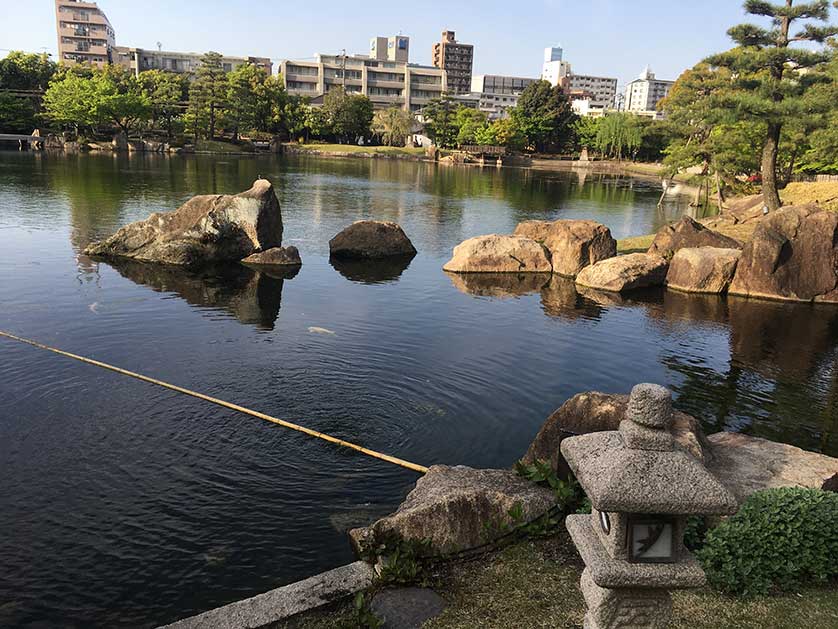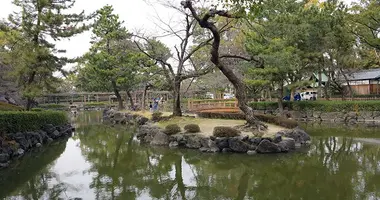Tokugawa Garden: A historic Japanese oasis in Nagoya
- Published on : 09/07/2024
- by : Japan Experience
- Youtube

The central pond at the Tokugawa Garden in Nagoya with the Kansenro in the background
Nestled in the heart of Nagoya, the Tokugawa Garden stands as a living testament to Japan's rich cultural heritage. This meticulously crafted landscape, once the private retreat of the powerful Tokugawa clan, now offers visitors a serene escape into traditional Japanese garden design. With its expansive pond, carefully placed rock formations, and seasonal flora, Tokugawa Garden invites you to step back in time and experience the beauty that has captivated visitors for centuries. As you wander through this historic oasis, you'll discover a miniature representation of Japan's diverse landscapes, from cascading waterfalls to tranquil lakes, all within the confines of this urban sanctuary.
The origins and history of Tokugawa Garden
The History of Tokugawa-en is deeply intertwined with the legacy of the Tokugawa clan. Constructed in 1695, the garden was originally designed as a retirement villa for Tokugawa Mitsutomo, the second lord of the Owari Tokugawa family. At its inception, the garden sprawled across an impressive 44 hectares, with a lake so vast it could accommodate a 16-oar boat. This grandiose scale reflected the immense power and wealth of the Tokugawa shogunate during the Edo period.
After Mitsutomo's death, the garden passed through various hands, including those of the Owari Tokugawa's chief retainers. However, the garden's fortunes took a dramatic turn during World War II, when it was largely destroyed by bombing. Miraculously, the Kuro-mon (Black Gate), dating back to 1900, survived the destruction, standing as a silent witness to the garden's tumultuous history.
It wasn't until 2004 that Tokugawa Garden was fully restored and reopened to the public. This restoration aimed to recreate the garden's former glory while adapting it for modern visitors. Today, the garden stands as a beautiful blend of historical authenticity and contemporary accessibility, offering a unique glimpse into the aesthetic sensibilities of feudal Japan.
Design and layout of the garden: A miniature representation of Japan's landscapes
The Tokugawa Garden exemplifies the art of Japanese landscape design, skillfully condensing the diverse natural beauty of Japan into a compact space. At the heart of the garden lies the expansive Ryusenko Lake, symbolizing the vastness of the ocean and serving as the focal point around which the rest of the garden is arranged.
Surrounding the lake, visitors will find a variety of carefully crafted landscapes. The garden features dramatic waterfalls, meticulously placed rock formations, and delicate wooden bridges, each element thoughtfully positioned to create a harmonious whole. One of the most striking features is the Ozone no Taki, a six-meter-high, three-tiered waterfall that cascades into the lake, creating a mesmerizing focal point and lending its name to the surrounding area.
The garden's design also incorporates the principle of "borrowed scenery" (shakkei), a technique that integrates distant landscapes into the garden's composition. This is evident in the Seikotei levee, which recalls the West Lake in Hangzhou, China, showcasing the Tokugawa family's interest in foreign aesthetics.

The 6m, three-tiered Ozone no Taki waterfall at the Tokugawa Garden; streams, ponds and waterfalls are central features of this delightful strolling garden
Seasonal beauty: Flora and fauna throughout the year
One of the most captivating aspects of Tokugawa Garden is its ever-changing seasonal beauty. The garden is home to a diverse array of plant species, carefully selected to provide visual interest throughout the year. Visitors can enjoy the delicate blossoms of Japanese apricot (ume) trees in late winter, followed by the iconic cherry blossoms in spring.
As spring transitions to summer, the garden bursts into color with its famous peonies (botan) and irises (hanashobu). These flowers, best viewed in April and June respectively, create stunning displays that draw visitors from far and wide. The summer months also see the lush greenery of maples and black pines providing cool shade and tranquil vistas.
Autumn brings its own spectacular show as the maple trees turn brilliant shades of red and gold. This season is particularly popular among visitors, who come to witness the stunning fall foliage reflected in the still waters of Ryusenko Lake.
Even in winter, the garden maintains its allure with evergreen pines and carefully pruned shrubs standing out against the stark landscape. The occasional snowfall transforms the garden into a serene winter wonderland, offering yet another perspective on its timeless beauty.

Peony (botan), The Tokugawa-en Garden, Ozone, Nagoya
Notable features and structures within the garden
Throughout Tokugawa Garden, visitors will encounter a variety of structures and features that enhance the garden experience. The journey begins at the Kuro-mon (Black Gate), an impressive wooden structure that survived the wartime destruction and now serves as the main entrance to the garden.
As you explore, you'll come across several tea houses, including the samurai tea house, which offer glimpses into the refined world of Japanese tea ceremony. These structures provide perfect vantage points from which to admire the garden's beauty and contemplate its design.
One of the most prominent buildings in the garden is the two-storied Kansenro. This multi-purpose structure serves as a restaurant, shop, and auditorium. Its location overlooking the central pond offers diners breathtaking views of the garden while they enjoy traditional Japanese cuisine.
The garden also features several bridges that span the waterways and connect different areas. These bridges not only serve a practical purpose but also act as artistic elements in their own right, their graceful arches reflected in the water below.
For those interested in the garden's water features, the Ryumon no Taki waterfall is a must-see. This cleverly designed waterfall includes a mechanism that causes a sudden surge of water, covering the stepping stones once crossed - a feature that delighted feudal lords during garden parties of old.
The Tokugawa Art Museum: A complementary cultural experience
Adjacent to the Tokugawa Garden lies the Tokugawa Art Museum, offering visitors a chance to delve deeper into the history and culture of the Tokugawa clan. The museum houses an impressive collection of over 10,000 items, including 9 National Treasures and 59 Important Cultural Properties.
One of the museum's most prized possessions is the 12th-century Tale of Genji Illustrated Scrolls, a National Treasure that provides a rare glimpse into the aesthetics and storytelling of Japan's classical period. The museum's collection also includes samurai armor, swords, Noh costumes, and various art objects that once belonged to the Tokugawa family.
Visitors can purchase a combined ticket for both the garden and the museum, allowing for a comprehensive exploration of Tokugawa heritage. The museum complements the garden experience by providing historical context and showcasing the artistic treasures that would have once adorned the residences of the Tokugawa lords.

Tokugawa Garden was laid out in 1695 as a retirement villa for Mitsutomo, Lord of the wealthy Owari Tokugawa
Visitor information and how to make the most of your visit
To fully appreciate Tokugawa Garden, it's helpful to know some practical information. The garden is open from 9:30 am to 5:30 pm, with last entry at 5:00 pm. It's closed on Mondays (unless Monday is a national holiday, in which case it closes the following Tuesday) and from late December to early January.
Getting to Tokugawa-en is convenient via public transport. From Meijo Line of the Nagoya subway, alight at Ozone Station and walk south for about 15 minutes. Alternatively, buses from Oasis 21 in Sakae or Nagoya Station stop at Tokugawa-en Shindeki, just a short walk from the garden entrance.
To make the most of your visit:
- Consider visiting during different seasons to experience the garden's changing beauty.
- Take advantage of the guided tours offered by the garden staff for deeper insights into its history and design.
- Don't miss the opportunity to enjoy traditional tea in one of the garden's tea houses.
- Visit the Tokugawa Art Museum to complement your garden experience with historical artifacts.
- Check the garden's event calendar for special illuminations and cultural performances.
The significance of Tokugawa Garden in Japanese garden culture
Tokugawa Garden holds a special place in Japanese garden culture, representing the pinnacle of Edo-period garden design. Its restoration and preservation serve as a vital link to Japan's feudal past, offering modern visitors a chance to experience the aesthetic sensibilities of the Tokugawa era.
The garden exemplifies several key principles of Japanese garden design, including the use of borrowed scenery, the creation of miniature landscapes, and the importance of seasonal change. It stands as a testament to the Japanese appreciation for nature and the art of creating harmonious environments that blend the natural and the man-made.
Moreover, Tokugawa Garden's connection to the powerful Tokugawa clan adds historical significance to its beauty. It serves as a living museum of Japanese cultural history, offering insights into the lives and tastes of the feudal lords who once ruled Japan.
For garden enthusiasts and historians alike, Tokugawa Garden is a must-visit destination. It not only provides a peaceful retreat within the bustling city of Nagoya but also offers a deep dive into the art, culture, and history of Japan. Whether you're admiring the reflection of autumn maples in Ryusenko Lake, contemplating the carefully placed rocks, or simply enjoying the tranquility of this urban oasis, Tokugawa Garden offers a timeless experience that connects visitors to the heart of Japanese aesthetic traditions.
As you plan your visit to Nagoya, be sure to include Tokugawa Garden in your itinerary. It's not just a complement to other attractions like Nagoya Castle or Atsuta Shrine, but a destination in its own right, offering a unique window into Japan's cultural soul. For those seeking to deepen their understanding of Japanese gardens, consider exploring Books on Japanese Gardens to enhance your appreciation of this magnificent site.

















